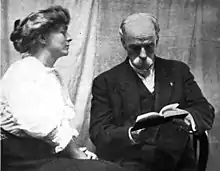Hildegarde Hawthorne
Hildegarde Hawthorne (September 25, 1871 – December 10, 1952) was an American writer of supernatural and ghost stories, a poet and biographer.
Hildegarde Hawthorne | |
|---|---|
 Hildegarde Hawthorne and her father Julian Hawthorne, from a 1907 publication. | |
| Born | September 25, 1871 New York, United States |
| Died | December 10, 1952 Danbury, Connecticut, United States |
| Other names | Hildegarde Oskison |
| Occupations |
|
| Spouse | |
| Parent(s) | Julian Hawthorne Minnie Amelung |
Family
Born on September 25, 1871, in New York City, Hildegarde Hawthorne was the granddaughter of Nathaniel Hawthorne (1804–1864) and eldest child of Julian Hawthorne (1846–1934) and Minnie Amelung Hawthorne.[1][2] She lived in Germany, England, and Jamaica as a child.[3]
Career
At age sixteen Hildegarde began selling articles to the children's magazine St. Nicholas. Her supernatural short story "Perdita," was published in the March 1897 Harper's Magazine.[4] She wrote biographies of Nathaniel Hawthorne, Henry Wadsworth Longfellow, Ralph Waldo Emerson, Henry David Thoreau, Thomas Paine, Matthew Fontaine Maury, and Oliver Wendell Holmes Sr.[1]
Hawthorne also wrote travel narratives, including Old Seaport Towns of New England (1916),[5] Rambles in Old College Towns (1917),[6] Corsica: The Surprising Island (1926),[7] Romantic Cities of California (1939),[8] and Williamsburg, Old and New (1941).[9]
Hawthorne marched in the 1913 women's suffrage parade in New York City.[10] She lived in California in the 1920s and 1930s.[11]
A collection of ghost stories by Hawthorne, The Faded Garden, was published in 1985, edited by Jessica Amanda Salmonson. Her work is sometimes found in anthologies of American women's writing.[3]
Personal life
Hildegarde Hawthorne married John Milton Oskison in 1920. She died in 1952, aged 81 years, in Danbury, Connecticut.
References
- Hanley, Terence E. (2012-12-06). "Tellers of Weird Tales: Hildegarde Hawthorne (1871-1952)". Tellers of Weird Tales. Retrieved 2020-01-04.
- "Genius of Writing in Hawthorne Kin". Lansing State Journal. 1930-03-21. p. 14. Retrieved 2020-01-04 – via Newspapers.com.
- Lundie, Catherine A. (1996). Restless Spirits: Ghost Stories by American Women, 1872-1926. Univ of Massachusetts Press. p. 68. ISBN 978-1-55849-056-7.
- Hawthorne, Hildegarde (March 1897). "Perdita". Harper's Magazine. ISSN 0017-789X. Retrieved 2020-01-04.
- Hawthorne, Hildegarde (1916). Old Seaport Towns of New England. Dodd, Mead.
- Hawthorne, Hildegarde. (1917). Rambles in old college towns. New York: Dodd, Mead & Co.
- "Corsica the Surprising Island by Hildegarde Hawthorne". The Kelmscott Bookshop. Retrieved 2020-01-04.
- Hawthorne, Hildegarde. Romantic Cities of California (1939), in the collection of the Metropolitan Museum of Art.
- Hawthorne, Hildegarde (1941). Williamsburg, Old and New. D. Appleton-Century Company.
- Seger, Donna (2016-09-11). "Hildegarde Hawthorne Hits Salem". Streets of Salem. Retrieved 2020-01-04.
- "Story Treat for Children at Ukiah Library". Ukiah Republican Press. 1935-05-15. p. 4. Retrieved 2020-01-04 – via Newspapers.com.